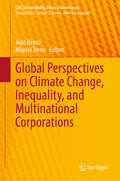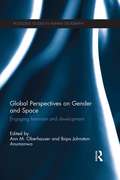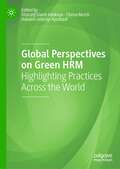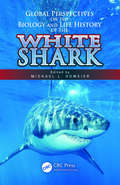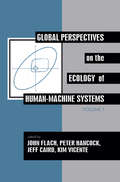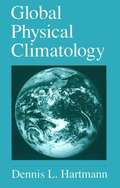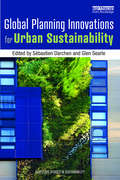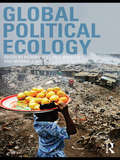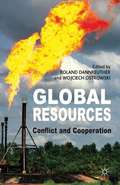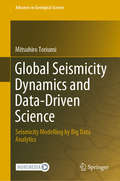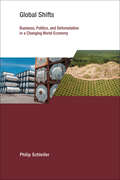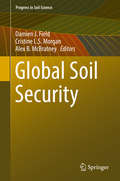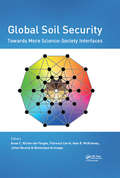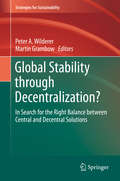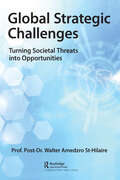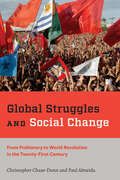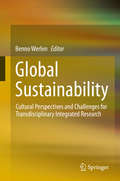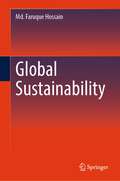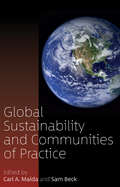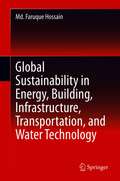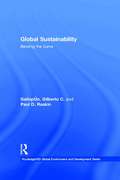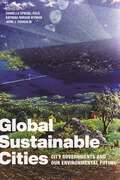- Table View
- List View
Global Perspectives on Climate Change, Inequality, and Multinational Corporations (CSR, Sustainability, Ethics & Governance)
by João Bento Miguel M. TorresComprising a collection of selected research papers, this book discusses the challenges related to climate change mitigation and adaptation. It adds valuable insights into the link between climate change, global inequality, and multinational corporations. Bringing together an international range of prominent authors, this book interests academics, students, and practitioners. It serves as a valuable guide for policymakers in environmental sustainability. This book encourages researchers to think more broadly about the implications of multinational corporations concerning global inequality and climate change. It deepens understanding of how foreign direct investments can contribute to a more sustainable future and overcome environmental challenges.
Global Perspectives on Gender and Space: Engaging Feminism and Development (Routledge Studies in Human Geography)
by Ann M. Oberhauser and Ibipo Johnston-AnumonwoFeminism has re-shaped the way we think about equality, power relations and social change. Recent feminist scholarship has provided new theoretical frameworks, methodologies and empirical analyses of how gender and feminism are situated within the development process. Global Perspectives on Gender and Space: Engaging Feminism and Development draws upon this framework to explore the effects of globalization on development in diverse geographical contexts. It explores how women’s and men’s lives are gendered in specific spaces as well as across multiple landscapes. Traveling from South Asia to sub-Saharan Africa to North America and the Caribbean, the contributions illustrate the link between gender and global development, including economic livelihoods, policy measures and environmental change. Divided into three sections, Global Perspectives on Gender and Space showcases the following issues: One) the impact of neoliberal policies on transnational migration, public services and microfinance programs; Two) feminist and participatory methodologies employed in the evaluation of land use, women’s cooperatives and liberation struggles and Three) gendered approaches to climate change, natural disasters and conservation the global South. A feminist lens is the common thread throughout these sections that weaves gender into the very fabric of everyday life, providing a common link between varied spaces around the globe by mapping gendered patterns of power and social change. This timely volume provides geographic comparisons and case studies to give empirically informed insights on processes and practices relevant to feminism and development. It illustrates ways to empower individuals and communities through transnational struggles and grassroots organizations, while emphasizing human rights and gender equity, and will be of interest to those studying Geography, Development Studies, International Relations and Gender Studies.
Global Perspectives on Green HRM: Highlighting Practices Across the World
by Chima Mordi Hakeem Adeniyi Ajonbadi Olatunji David AdekoyaEnvironmental sustainability has become increasingly important because of irreversible climate change, widespread environmental pollution, and dwindling resource availability over time. Organisations have recently come under more pressure due to increasing economic, political, and societal concerns to address environmental issues and improve their environmental performance. Recently, green human resource management (Green HRM), among other sustainable environmental strategies adopted by organisations, has gained popularity, yet little has been published on green HRM practices across the globe.This book develops our understanding and practice of green HRM across the globe, highlighting practices across different countries on different continents, with a particular focus on the Global South. The authors draw on various types of research (conceptual, theoretical and empirical) and incorporate contextual issues such as technology, politics, culture, and economics to supplement the readers’ insights into the current state of green HRM practices across the globe. By highlighting theoretical underpinnings and emphasising the practical relevance of green HRM practices, this book offers an insightful guide for scholars and students of HRM, as well as HR professionals looking for an academic insight to this vitally important area.
Global Perspectives on the Biology and Life History of the White Shark
by Michael L. DomeierInspired by the International White Shark Symposium in 2010, Global Perspectives on the Biology and Life History of the White Shark incorporates the most important contemporary research findings into a single peer-reviewed book. This beautifully illustrated reference represents a historic change in the context of White Shark (Carcharodon carcharias
Global Perspectives on the Ecology of Human-Machine Systems (Resources for Ecological Psychology Series)
by John Flach, Peter Hancock, Jeff Caird and Kim VicenteThere is a growing consensus in the human factors/ergonomics community that human factors research has had little impact on significant applied problems. Some have suggested that the problem lies in the fact that much HF/E research has been based on the wrong type of psychology, an information processing view of psychology that is reductionistic and context-free. Ecological psychology offers a viable alternative, presenting a richer view of human behavior that is holistic and contextualized. The papers presented in these two volumes show the conceptual impact that ecological psychology can have on HF/E, as well as presenting a number of specific examples illustrating the ecological approach to human-machine systems. It is the first collection of papers that explicitly draws a connection between these two fields. While work in this area is only just beginning, the evidence available suggests that taking an ecological approach to human factors/ergonomics helps bridge the existing gap between basic research and applied problems.
Global Physical Climatology
by Dennis L. HartmannThis textbook provides an introduction to the physical interactions in the climate system, viewed from a global perspective and is a useful text for upper-division undergraduate physical science majors and, especially in the later chapters, graduate students.
Global Planning Innovations for Urban Sustainability (Routledge Studies in Sustainability)
by Sébastien Darchen Glen SearleAs the world becomes more urbanised, solutions are required to solve current challenges for three arenas of sustainability: social sustainability, environmental sustainability and urban economic sustainability. This edited volume interrogates innovative solutions for sustainability in cities around the world. The book draws on a group of 12 international case studies, including Vancouver and Calgary in Canada, San Francisco and Los Angeles in the US (North America), Yogyakarta in Indonesia, Seoul in Korea (South-East Asia), Medellin in Colombia (South America), Helsinki in Finland, Freiburg in Germany and Seville in Spain (Europe). Each case study provides key facts about the city, presents the particular urban sustainability challenge and the planning innovation process and examines what trade-offs were made between social, environmental and economic sustainability. Importantly, the book analyses to what extent these planning innovations can be translated from one context to another. This book will be essential reading to students, academics and practitioners of urban planning, urban sustainability, urban geography, architecture, urban design, environmental sciences, urban studies and politics.
Global Political Ecology
by Richard Peet Paul Robbins Michael WattsThe world is caught in the mesh of a series of environmental crises. So far attempts at resolving the deep basis of these have been superficial and disorganized. Global Political Ecology links the political economy of global capitalism with the political ecology of a series of environmental disasters and failed attempts at environmental policies. This critical volume draws together contributions from twenty-five leading intellectuals in the field. It begins with an introductory chapter that introduces the readers to political ecology and summarizes the books main findings. The following seven sections cover topics on the political ecology of war and the disaster state; fuelling capitalism: energy scarcity and abundance; global governance of health, bodies, and genomics; the contradictions of global food; capital’s marginal product: effluents, waste, and garbage; water as a commodity, a human right, and power; the functions and dysfunctions of the global green economy; political ecology of the global climate, and carbon emissions. This book contains accounts of the main currents of thought in each area that bring the topics completely up-to-date. The individual chapters contain a theoretical introduction linking in with the main themes of political ecology, as well as empirical information and case material. Global Political Ecology serves as a valuable reference for students interested in political ecology, environmental justice, and geography.
Global Project Finance, Human Rights and Sustainable Development
by David Ong Sheldon LeaderMany infrastructure projects around the world are funded through the project finance method, which combines private financing with public sector backing from multilateral finance institutions such as the World Bank. This examination of the theoretical and practical implications of such funding begins with a discussion of the relationship between the financial structuring of these projects and finance, policy and legal disciplines, especially in the form of investment law, human rights and environmental law. A number of case studies are then examined to provide practical insights into the application (or otherwise) of human rights and sustainable development objectives within such projects. While these theoretical perspectives do not conclude that the project finance method detracts from the application or implementation of human rights and sustainable development objectives, they do highlight the potential for the prioritisation of investment returns at the expense of human rights and environmental protection standards.
Global Resources
by Roland Dannreuther Wojciech OstrowskiThis EU-funded project examines the dynamics of conflict, collaboration and competition in relation to access to oil, gas and minerals. It involves 12 different institutions from across the EU and examines oil, gas and other minerals - spanning geology, technology studies, sociology, economics and political science.
Global Science: Earth/Environmental Systems Science
by John Christensen Teri ChristensenNIMAC-sourced textbook
Global Seismicity Dynamics and Data-Driven Science: Seismicity Modelling by Big Data Analytics (Advances in Geological Science)
by Mitsuhiro ToriumiThe recent explosion of global and regional seismicity data in the world requires new methods of investigation of microseismicity and development of their modelling to understand the nature of whole earth mechanics. In this book, the author proposes a powerful tool to reveal the characteristic features of global and regional microseismicity big data accumulated in the databases of the world. The method proposed in this monograph is based on (1) transformation of stored big data to seismicity density data archives, (2) linear transformation of microseismicity density data matrixes to correlated seismicity matrixes by means of the singular value decomposition method, (3) time series analyses of globally and regionally correlated seismicity rates, and (4) the minimal non-linear equations approximation of their correlated seismicity rate dynamics. Minimal non-linear modelling is the manifestation for strongly correlated seismicity time series controlled by Langevin-type stochastic dynamic equations involving deterministic terms and random Gaussian noises. A deterministic term is composed minimally with correlated seismicity rate vectors of a linear term and of a term with a third exponent. Thus, the dynamics of correlated seismicity in the world contains linearly changing stable nodes and rapid transitions between them with transient states. This book contains discussions of future possibilities of stochastic extrapolations of global and regional seismicity in order to reduce earthquake disasters worldwide. The dataset files are available online and can be downloaded at springer.com.
Global Shifts: Business, Politics, and Deforestation in a Changing World Economy
by Philip SchleiferWhat global shifts in markets and power mean for the politics and governance of sustainability.In recent years, major shifts in global markets from North to South have created a new geography of trade and consumption, particularly in the agricultural sector. How this shift affects the governance of sustainability, and thus the future of the planet, is the pressing topic Philip Schleifer takes up in this book. The processes of twenty-first-century globalization are fundamentally changing the politics and governance of commodity production, Schleifer argues, with profound implications for the environment in the food-producing countries of the Global South. At the center of Schleifer's study are Brazil and Indonesia—two key sites of experimentation in new models of global environmental and commodity governance—where palm oil and soy supply chains have seen unprecedented degrees of private environmental governance in recent years. However, instead of transforming these industries, the diffusion of transnational sustainability standards has accompanied a worsening ecological crisis, with mounting evidence of increasingly strong links between deforestation and globalization in twenty-first-century agricultural trade. To uncover the causes of this governance failure, Schleifer develops a multi-level framework for analyzing how contemporary globalization is reconfiguring the political economies of such industries. The result is the first comprehensive analysis of the shift of global agricultural trade to the South and the deepening crisis of commodity-driven deforestation—and a complex and evolving picture of both the risks and opportunities for sustainability presented by this transformative shift.
Global Soil Security
by Alex B. Mcbratney Damien J. Field Cristine L. S. MorganThis book introduces the concept of soil security and its five dimensions: Capability, Capital, Condition, Connectivity and Codification. These five dimensions make it possible to understand soil's role in delivering ecosystem services and to quantify soil resource by measuring, mapping, modeling and managing it. Each dimension refers to a specific aspect: contribution to global challenges (Capability), value of the soil (Capital), current state of the soil (Condition), how people are connected to the soil (Connectivity) and development of good policy (Codification). This book considers soil security as an integral part of meeting the ongoing challenge to maintain human health and secure our planet's sustainability. The concept of soil security helps to achieve the need to maintain and improve the world's soil for the purpose of producing food, fiber and freshwater, and contributing to energy and climate sustainability. At the same time it helps to maintain biodiversity and protects ecosystem goods and services.
Global Soil Security (Progress in Soil Science)
by Damien J. Field, Cristine L. S. Morgan and Alex B. McBratneyThis book introduces the concept of soil security and its five dimensions: Capability, Capital, Condition, Connectivity and Codification. These five dimensions make it possible to understand soil's role in delivering ecosystem services and to quantify soil resource by measuring, mapping, modeling and managing it. Each dimension refers to a specific aspect: contribution to global challenges (Capability), value of the soil (Capital), current state of the soil (Condition), how people are connected to the soil (Connectivity) and development of good policy (Codification). This book considers soil security as an integral part of meeting the ongoing challenge to maintain human health and secure our planet's sustainability. The concept of soil security helps to achieve the need to maintain and improve the world’s soil for the purpose of producing food, fiber and freshwater, and contributing to energy and climate sustainability. At the same time it helps to maintain biodiversity and protects ecosystem goods and services.
Global Soil Security: Proceedings of the Global Soil Security 2016 Conference, December 5-6, 2016, Paris, France (Progress In Soil Science Ser.)
by Alex B. McBratney Dominique Arrouays Florence Carre Anne Richer de ForgesSoil, this highly pressurized and crucial resource, is indispensable partner to meet sustainable development goals. The demonstration is done by linking businesses, practitioners, policymakers and researchers on soil security dimensions through good working practices, business solutions, scientific outcomes and international initiatives that enhance protection and sustainable management of soils. The book will gather reviwed full papers of keynotres and presentation given at the 2nd international conference on Global Soil Security held in Paris, on 5-6 December 2016.
Global Stability through Decentralization?
by Peter A. Wilderer Martin GrambowThe authors of this book, who represent a broad range of scientific disciplines, discuss the issue of centralized versus decentralized control and regulation in the context of sustainable development. The stability and resilience of complex technical, economic, societal and political systems are commonly assumed to be highly dependent on the effectiveness of sophisticated, mainly centralized regulation and control systems and governance structures, respectively. In nature, however, life is mainly self-regulated by widespread, mainly DNA-encoded control mechanisms. The fact that life has endured for more than 2. 4 billion years suggests that, for man-made systems, decentralized control concepts are superior to centralized ones. The authors discuss benefits and drawbacks of both approaches to achieving sustainability, providing valuable information for students and professional decision makers alike.
Global Strategic Challenges: Turning Societal Threats into Opportunities
by Walter Amedzro St-HilaireFrom his position as a Senior Fellow, the author addresses in this book the structural challenges and difficulties that predate Covid pandemic: climate change, economic inequality and the demographic challenge. These challenges raise fundamental questions of equity both between and within generations. Their immediate effects are much weaker than their long-term effects, which encourages policymakers to delay. But the cost of meeting them increases over time. These menaces raise complex technical and economic issues; some decisions must be made under great uncertainty. For each of these challenges, solutions exist: why is there little progress and how to turning threats into opportunities? In all cases, technological change is a central aspect, constituting both part of the problem and part of the solution. The solutions the author formulates are of two kinds: policy recommendations and exploratory strategic proposals. Some of the recommendations include measures that have been widely discussed but never implemented. The author wonders why these measures were never implemented? Some of the strategies are more exploratory in nature because they are new or their effects are less well understood, or because the risks associated with their implementation are significant. The author effectively analyzes the different options for exiting the crisis and explains how his proposals differ from the current reforms for global warming, inequality and population aging.
Global Struggles and Social Change: From Prehistory to World Revolution in the Twenty-First Century
by Paul Almeida Christopher Chase-DunnDeftly demonstrates how the rise and fall of social movements throughout history is closely linked to economic and political developments.In the early decades of the twenty-first century, an international movement to slow the pace of climate change mushroomed across the globe. The self-proclaimed Climate Justice movement urges immediate action to reduce carbon emissions and calls for the adoption of bold new policies to address global warming before irreversible and catastrophic damage threatens the habitability of the planet. On another front, since the 1980s, multiple waves of resistance have occurred around the world against the uneven transition from state-led development to the neoliberal globalization project. Both Climate Justice and Anti-Austerity movements represent the urgency of understanding how global change affects the ability of citizens around the world to mobilize and protect themselves from planetary warming and the loss of social protections granted in earlier eras.In Global Struggles and Social Change, Christopher Chase-Dunn and Paul Almeida explore how global change stimulates the formation and shape of such movements. Contending that large-scale economic shifts condition the pattern of social movement mobilizations around the world, the authors trace these trends back to premodern societies, revealing how severe disruptions of indigenous communities led to innovative collective actions throughout history. Drawing on historical case studies, world system and protest event analysis, and social networks, they also examine the influence of global change processes on local, national, and transnational social movements and explain how in turn these movements shape institutional shifts. Touching on hot-button topics, including global warming, immigrant rights protests, the rise of right-wing populism, and the 2008 financial crisis, the book also explores a broad range of premodern social movements from indigenous people in the Americas, Mesopotamia, and China. The authors pay special attention to periods of disruption and external threats, as well as the role of elites, emotions, charisma, and religion or spirituality in shaping protest movements. Providing sweeping coverage, Global Struggles and Social Change is perfect for students and anyone interested in globalization, international and comparative politics, political sociology, and communication studies.
Global Sustainability
by Benno WerlenThis book offers new perspectives of transdisciplinary research, in methodological as well as theoretical respects. It provides insights in the two-fold bio-physical and the socio-cultural global embeddedness of local living conditions on the basis of selected empirical studies from Latin America, Asia, Africa, Australia and Europe. The theoretical foundations of ecological research and sustainability policies were developed at the end of the nineteenth century. They are largely based on investigations of living spaces and the evolution and differentiation of varied life forms. This perspective is embedded in the practical and theoretical European problem situations of the past and lacks social and cultural differentiation. The transformation of spatial and natural relations as a result of the globalization process is so radical that new theories are needed to solve 21st century ecological problems. Moreover, in view of the lack of an ontologically sound and promising strategy for transdisciplinary problem solving, as well as an acceptable consideration of the power of cultural schemas relating to natural living's interpretations, there is a strong need to focus on sustainable social practices, habits and routines, rather than on predominantly living spaces or eco-topes. This book elaborates on the transdisciplinary approach by reflecting on the theoretical heritage and a global perspective of sustainability, by focusing on the primary role of a social approach in sustainability research and by putting emphasis on cultural dimension of sustainability. It postulates that global sustainability is grounded in a global understanding of our everyday activities.
Global Sustainability
by Md. Faruque HossainThis book focuses on holistic approaches to sustainability in all sectors of environment, energy, building, and infrastructure to achieve the best-balanced global environmental, energy, building, infrastructure, transportation, and water technologies (EBITWs). It presents a series of solutions based on innovative research and applications for building a sustainable Earth for future generations. Simply, the goal of this book is to define the context of instigation to think through the scientific theories and practical technical applications of sustainability for building a better planet. Naturally this book explains a series of mechanisms to develop a sustainable world by implementing mainly practicing the following areas of Sustainable Energy, Sustainable Housing and Building Technology, Sustainable Water, Infrastructure, and Transportation Technology, Sustainable Environment which are, very much interconnected to secure a global environmental equilibrium.
Global Sustainability and Communities of Practice
by Carl A. Maida Sam BeckCollaboration between experts and the public is vital for effective community engagement aimed at improving the lives of the most vulnerable in society, whether at the local or global level. Using case-based and theoretical chapters that examine rural and urban communities of practice, this volume illustrates how participatory researchers and students, as well as policy and community leaders, find ways to engage with the broader public when it comes to global sustainability research and practice.
Global Sustainability in Energy, Building, Infrastructure, Transportation, and Water Technology
by Md. Faruque HossainThis book focuses on holistic approaches to sustainability in all sectors of building, infrastructure, and energy to achieve a best-balanced global energy, building, infrastructure, transportation, and water technology (EBITW) system using a series of innovative research and implementation solutions. The goal of this book is to define the context for proactive consideration of scientific theories and practical technical applications of sustainable development, following main seven themes: Renewable Energy Technology, Advanced Building Design Technology, Innovative Infrastructure and Transportation Engineering, Clean Water and Sanitation, Sustainable Urban and Rural Development, Clean Environment, and Sustainable Planet; which are very much interconnected to secure the global equilibrium. The book is prepared for a wide audience including researchers, field engineers, and students.
Global Sustainability: Bending the Curve (Routledge/SEI Global Environment and Development Series #Vol. 3)
by Gilberto C. Gallopín Paul D. RaskinUnprecedented levels of wealth, technology and institutional capacity can forge a just, peaceful and ecologically resilient future. However, the authors argue, social polarization, geo-political conflict and environmental degradation are threatening the long-term well-being of humanity and the planet. Global Sustainability explores the alternative futures that could emerge from the resolution of these antagonisms. Based on extensive international and interdisciplinary research, the book identifies the perils of market-driven scenarios and considers the possibility of the failure of conventional approaches. It also, however, presents a vision of the possibility of a 'Great Transition' in which revised human values and development goals bring a new stage of civilization. It will be essential reading for all scholars and professionals interested in the future of the environment, international affairs, and sustainable development.
Global Sustainable Cities: City Governments and Our Environmental Future
by Danielle Spiegel-Feld, Katrina Miriam Wyman, and John J. CoughlinPerspectives from worldwide experts on how major cities across the globe are responding to the major environmental threats of our time, including global climate change Over half of the world’s population now lives in cities, and this share is expected to increase in the coming decades. With growing urbanization, cities and their residents face substantial environmental challenges such as higher temperatures, droughts, wildfires, and increased flooding. In response to these pressing challenges, some cities have begun to develop local environmental regulations that supplement national and environmental laws. In so doing, cities have stepped into a role that has been historically dominated by higher levels of government.Global Sustainable Cities takes stock of the policies that have been implemented by cities around the world in recent years in several key areas: water, air pollution, greenhouse gas emissions, and climate adaptation. It examines the advantages—and potential drawbacks—of allowing cities to assume a significant role in environmental regulation, given the legal and political constraints in which cities operate.The contributors present a series of case studies of the actions that seven leading cities—Abu Dhabi, Beijing, Berlin, Delhi, London, New York, and Shanghai—are taking to improve their environments and adapt to climate change. The first volume of its kind, Global Sustainable Cities is a critical comparative assessment of the actions that major cities in the global North and South are taking to advance sustainability.
